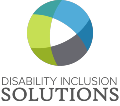The goal of universal design is to create a space that considers and anticipates the needs of all its users, regardless of age, abilities, or circumstance. It encompasses everything from the layout of a room to the products used within it.

There are seven principles used to define Universal Design. Each of the seven serves as a guideline for designing environments and products. They ensure the design:
- is accessible to people with diverse abilities and disabilities.
- can be used in different ways by different people.
- is easy to use and understand.
- provides information that is easy to see, hear, and touch.
- minimizes the possibility of errors.
- can be used with minimal physical effort.
- allows users to approach, reach, and use it comfortably.
At Disability Inclusion Solutions, we’ve teamed with Progressive AE, a firm with more than 65 years of combined experience in architecture and design, to help clients adhere to the seven principles and receive UD certification. Our process begins with a comprehensive meeting to fully understand our clients’ needs and wants. After that, we:
- guide our clients through the process.
- evaluate the space and identify strategies for change based on the UD checklist.
- make recommendations based on the seven principles.
- propose changes based on UD strategies.
- monitor the project and continue to make improvements as needed.
- recommend certification to the Global Universal Design Commission once all UD measures have been implemented.
Universal design aims to make spaces and experiences inclusive to all. It is a critical tool in allowing people to fully participate in the workplace, leading to a more inclusive society where everyone can benefit from the same spaces and products. Are you interested in learning how to get your building UD certified? Reach out to me. Our team will evaluate your situation and help you get started.





0 Comments